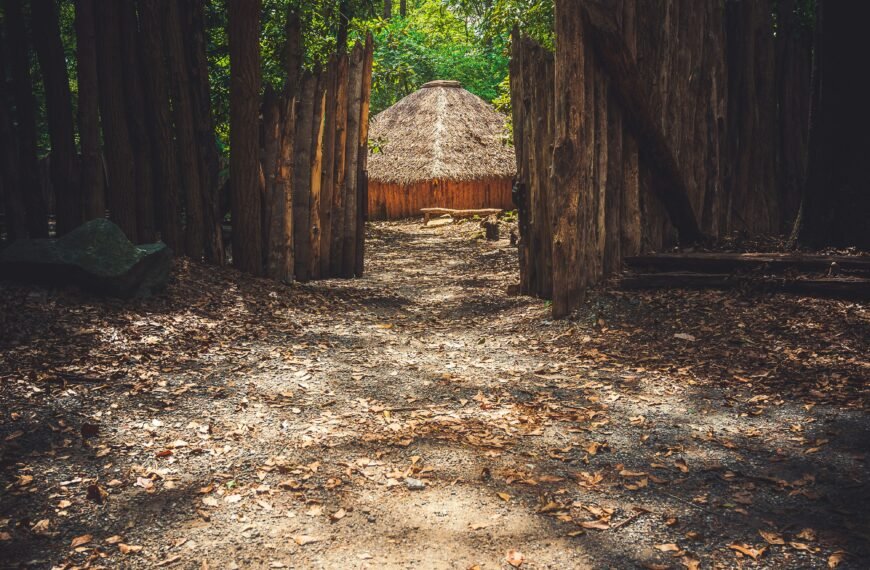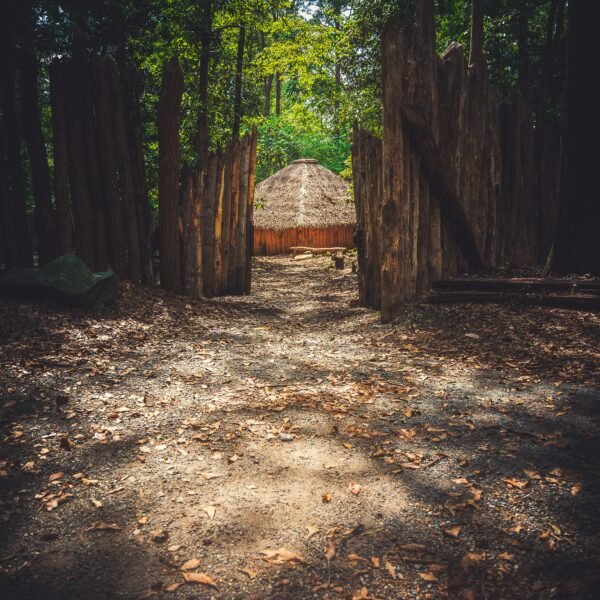The article “Preserving Praise Houses: Honoring African American History and Heritage” explores the significance of preserving praise houses, small structures used by enslaved people as places of worship in coastal plantations of the Carolinas and Georgia. These praise houses, often humble one-room buildings, hold immense historical and cultural value as they served as the cradle of the Black church and helped African Americans maintain a connection to their African lineage. However, many of these structures have been lost or left to deteriorate due to various factors. To combat this, churches, communities, and artists have initiated restoration projects and art installations to commemorate the rich history and traditions associated with praise houses. By preserving these sites, we honor our ancestors and ensure that African American history and heritage are maintained for generations to come.

I. The Significance of Praise Houses
Praise Houses hold immense significance in the history and culture of African Americans. These humble one-room structures were used as places of worship by enslaved people on coastal plantations in the Carolinas and Georgia.
A. Praise Houses as Cradle of the Black Church
Praise houses are considered the cradle of the Black church, as they provided a space for enslaved African Americans to practice their faith, express their spirituality, and form strong religious communities. In these small and intimate spaces, enslaved individuals could find solace and strength in their shared beliefs, despite the oppressive conditions they faced.
B. Connection to African Lineage
Praise houses also served as a vital link to African lineage. Through the practice of African spiritual traditions and oral storytelling, praise houses helped African Americans maintain their cultural identity and connect with their ancestral roots. These places of worship played a crucial role in preserving African customs and promoting a sense of pride and resilience within the community.
C. Multi-purpose Functionality of Praise Houses
In addition to serving as places of worship, praise houses had a multi-purpose functionality. They became community centers where enslaved individuals could gather for various activities, such as social gatherings, educational programs, and political meetings. Praise houses were essential in fostering a sense of unity and providing support to African Americans facing adversity.
II. Modern Challenges to Preservation
Despite their historical and cultural significance, praise houses face numerous challenges that threaten their preservation and restoration.
A. Destruction and Deterioration
Over time, many praise houses have been torn down or left to deteriorate due to neglect and lack of maintenance. Some of these structures have fallen victim to urban development, while others have succumbed to natural disasters or simply decayed over time. The destruction and deterioration of praise houses have resulted in the loss of important historical and cultural artifacts.
B. Climate Change Impacts
Climate change poses a significant threat to the preservation of praise houses. Rising sea levels, increased flooding, and the intensification of storms put these vulnerable structures at risk. Coastal areas, where many praise houses are located, are particularly susceptible to these environmental challenges. Efforts must be made to protect and restore praise houses to ensure their survival in the face of climate change.
C. Development and Urbanization
The rapid pace of development and urbanization has also impacted the preservation of praise houses. As cities expand and land values rise, historical structures, including praise houses, are often overlooked or demolished to make way for new constructions. The encroachment of development erases important cultural heritage and disrupts the historical fabric of communities.
D. Lack of Preservation Efforts
One of the biggest challenges in preserving praise houses is the lack of awareness and dedicated preservation efforts. Limited resources, funding constraints, and a general lack of recognition of the historical and cultural value of these structures hinder preservation initiatives. Without concerted efforts to save praise houses, their legacy and significance may be lost to future generations.
III. Restoration Projects Led by Churches
Recognizing the importance of preserving praise houses, churches have taken the lead in restoration efforts, ensuring the longevity and continued significance of these historic structures.
A. Importance of Church-led Preservation
Churches have a deep spiritual and historical connection to praise houses, making them natural advocates for their preservation. Through their restoration projects, churches demonstrate their commitment to honoring their ancestors and preserving their cultural heritage. Church-led preservation efforts also foster a sense of pride and ownership within the community, encouraging active engagement and support.
B. Community Collaboration in Restoration
Restoring praise houses often involves extensive collaboration with the local community. Church leaders, historians, architects, and preservationists work together to gather historical information, secure funding, and plan for the restoration process. Engaging the community allows for a shared sense of responsibility and creates a strong network of support for the preservation of praise houses.
C. Funding and Grant Programs
Preservation projects require significant funding, and churches have sought various sources to finance the restoration of praise houses. They often rely on grants from government agencies, private foundations, and community fundraising efforts. Grant programs specifically focused on historic preservation provide crucial financial support and incentivize churches to undertake restoration projects.
IV. Art Installations Commemorating Black History and Culture
Art installations play a critical role in preserving the history and culture associated with praise houses. They serve as powerful expressions of Black history, heritage, and resilience.
A. Role of Art in Preservation
Art has the ability to transcend time and evoke emotions, making it a powerful tool for preserving and commemorating the significance of praise houses. Art installations can capture the essence of the lived experiences of those who worshiped and sought refuge in these spaces while creating a tangible connection to history for future generations.
B. Symbolism and Representation
Art installations can incorporate symbols and visual representations that reflect the spiritual and cultural significance of praise houses. These symbols, such as the Ankh, Adinkra symbols, or woven patterns inspired by African textiles, serve as reminders of the African roots of praise houses and connect present-day communities to their rich cultural heritage.
C. Public Awareness and Education
Art installations in public spaces provide an opportunity to raise awareness about the historical importance of praise houses and Black culture. They educate the public about the legacy of slavery, the resilience of the African American community, and the importance of preserving these structures. Through public art, a broader audience can gain a deeper understanding of the contributions and struggles of African Americans.

V. Praise Houses as Spiritual Homes and Community Centers
Praise houses served as more than just places of worship. They were spiritual homes and community centers that played a crucial role in fostering a sense of belonging and support.
A. African Spiritual Traditions
Praise houses allowed enslaved African Americans to preserve and practice their African spiritual traditions, including rituals, dances, and songs. Through these practices, they maintained a connection to their ancestral roots and preserved important cultural rituals that had been forcibly stripped away during the enslavement years.
B. Community Bonding and Support
Praise houses became focal points for community bonding and support. Enslaved individuals would gather in these small spaces to celebrate, mourn, and seek solace from each other. Praise houses created a sense of fellowship, unity, and mutual support essential for survival in oppressive conditions.
C. Role in Cultural Preservation
The significance of praise houses extends beyond spiritual and community purposes. They played a central role in cultural preservation, as they provided a platform for the transmission of oral traditions, storytelling, and the passing down of cultural knowledge from one generation to the next. Praise houses played a pivotal role in ensuring the continuity and resilience of African American culture and heritage.
VI. The Preservation Movement as Ancestor Honoring
The preservation movement surrounding praise houses is deeply rooted in honoring the ancestors who built and worshiped within these sacred spaces.
A. Acknowledging the Ancestors
Preserving praise houses is an act of acknowledgement and gratitude towards the ancestors who endured unimaginable hardships and found solace and strength within these structures. Honoring the resilient spirits of those who came before is a way to ensure their stories are remembered and celebrated for generations to come.
B. Connection to African American History
Preserving praise houses is also intimately connected to African American history. These humble structures bear witness to the legacy of slavery, the strength of the Black community, and the ongoing fight for equality and social justice. By preserving praise houses, we preserve an important chapter in American history and shed light on the contributions and experiences of African Americans.
C. Celebrating Heritage and Identity
Preserving praise houses is a celebration of African American heritage and identity. By recognizing and valuing these historic structures, we affirm the enduring cultural legacy of African Americans. Praise houses stand as testament to the resilience and creativity of a community that has overcome immense challenges, and their preservation instills a sense of pride and belonging for African Americans today.

VII. Government Support and Historic Designation
Government support and historic designations play a crucial role in the preservation of praise houses.
A. Legislative Initiatives
Government agencies and legislators have recognized the importance of preserving cultural heritage and have implemented various initiatives to support the preservation of praise houses. These initiatives can include the creation of funding programs, tax incentives, and grants specifically aimed at historic preservation. Legislative support ensures that the preservation efforts are not solely reliant on community fundraising and facilitate broader access to resources.
B. National Historic Preservation Act
The National Historic Preservation Act of 1966 is a landmark legislation ensuring the preservation of historic properties, including praise houses. Under this act, properties of historical and cultural significance can be listed on the National Register of Historic Places, providing them with legal protection and access to federal preservation programs. Inclusion on the National Register provides praise houses with avenues for funding, recognition, and support.
C. State and Local Designations
In addition to national recognition, praise houses can also receive state and local designations that provide legal protection and support. State and local governments often have their own preservation programs, grants, and incentives to encourage the maintenance and restoration of historic properties. These designations highlight the importance of praise houses within the local context and promote their significance to the community.
VIII. Engaging Youth in Preservation Efforts
Engaging youth in preservation efforts is imperative for ensuring the continuation of praise house preservation and fostering a sense of cultural stewardship.
A. Importance of Youth Involvement
Youth involvement in preservation efforts brings fresh ideas, enthusiasm, and future leadership to the cause. Engaging young people creates a sense of ownership and pride in their cultural heritage, motivating them to actively participate in the preservation of praise houses and pass down this responsibility to future generations.
B. Educating the Next Generation
Preservation efforts should include educational programs that raise awareness about the historical and cultural significance of praise houses. By incorporating praise house preservation into school curricula and community programs, young people can learn about their heritage and develop a deep appreciation for the importance of cultural preservation.
C. Youth Volunteer Programs
Establishing youth volunteer programs focused on praise house preservation allows young individuals to actively contribute to the restoration and maintenance of these historic structures. These programs provide hands-on experiences and instill a sense of pride and responsibility in youth while fostering a lifelong commitment to cultural preservation.
IX. Preserving Praise Houses as Cultural Tourism
Preserving praise houses as cultural tourism destinations can bring economic benefits while promoting the appreciation of African American history and heritage.
A. Economic Benefits
Preserving praise houses as cultural tourism destinations can have significant economic benefits for local communities. By attracting visitors interested in the historical and cultural significance of these structures, communities can generate revenue through tourism-related activities such as guided tours, heritage festivals, and souvenir sales. This influx of visitors can stimulate local businesses, create jobs, and contribute to the overall economic growth of the area.
B. Cultural and Heritage Tourism
Praise houses serve as powerful symbols of African American history and culture. Preserving these structures as cultural tourism destinations enables visitors to engage with this history firsthand, deepening their understanding of African American heritage and promoting tolerance and cultural exchange. Cultural and heritage tourism fosters respect and appreciation for diverse cultures and contributes to a more inclusive society.
C. Preservation and Sustainable Tourism
Preserving praise houses as cultural tourism destinations must be done in a sustainable manner, ensuring that tourism activities do not negatively impact the integrity of the structures or the surrounding communities. Developing sustainable tourism practices not only safeguards the historical value of praise houses but also ensures that the benefits of tourism are shared equitably among local residents.
X. Future Prospects and Challenges
Although progress has been made in the preservation of praise houses, future efforts face ongoing challenges.
A. Evolving Preservation Techniques
Advances in preservation techniques, materials, and technologies offer promising prospects for the restoration and maintenance of praise houses. Incorporating these innovations into preservation efforts can help address challenges such as climate change impacts and deterioration. Continued research and collaboration between preservation experts, architects, and historians are crucial in developing effective and sustainable preservation strategies.
B. Financial and Resource Constraints
The availability of financial resources remains a significant challenge in preserving praise houses. Securing funding for restoration projects, ongoing maintenance, and community programs requires a concerted effort from federal, state, and local governments, as well as private institutions and individual donors. Leveraging public-private partnerships and exploring innovative financing models can help overcome financial constraints.
C. Building Preservation Networks
Establishing strong preservation networks is essential to tackle the challenges faced by praise house preservation. Collaborative efforts between churches, community organizations, historical societies, preservation professionals, and government agencies can pool resources, share knowledge, and amplify preservation efforts. By working together, these networks can create a collective impact that goes beyond individual restoration projects and ensures the long-term preservation of praise houses.
In conclusion, praise houses hold profound significance in African American history, heritage, and culture. Preserving these humble structures is crucial for honoring the ancestors, inspiring pride and resilience, and fostering a deep connection to African American identity. By addressing modern challenges, engaging the youth, and ensuring government support, we can work towards the sustainable preservation of praise houses, fostering cultural tourism, and securing a future where these important historical and cultural symbols thrive for generations to come.








